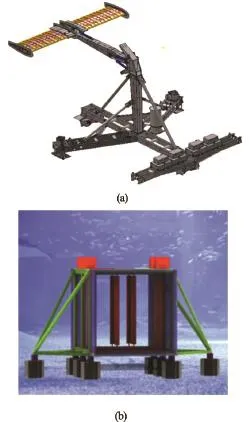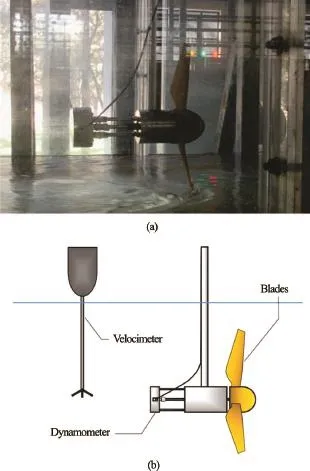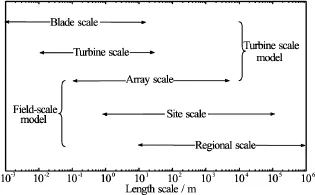Modelling hydrodynamic processes in tidal stream energy extraction*
Jie LIN (林杰), Bin-liang LIN (林斌良), Jian SUN (孙健), Ya-ling CHEN (陈娅玲)
Department of Hydraulic Engineering, Tsinghua University, Beijing 100084, China,
E-mail:linjie13@mails.tsinghua.edu.cn
Modelling hydrodynamic processes in tidal stream energy extraction*
Jie LIN (林杰), Bin-liang LIN (林斌良), Jian SUN (孙健), Ya-ling CHEN (陈娅玲)
Department of Hydraulic Engineering, Tsinghua University, Beijing 100084, China,
E-mail:linjie13@mails.tsinghua.edu.cn
Tidal stream energy is a type of marine renewable energy which is close to commercial-scale production. Tidal stream turbine arrays are considered as the one of the most promising exploitation methods. However, compared to the relatively mature technology of single turbine design and installation, the current knowledge on the hydrodynamic processes of tidal stream turbine arrays is still limited. Coastal models with simplified turbine representations based on the shallow water equation are among the most favorable methods for studying the tidal stream energy extraction processes in realistic sites. This paper presents a review of the progress and challenges in assessing the tidal stream energy.
tidal stream energy, coastal flow field, shallow water equations, turbine parameterization
Introduction
Marine renewable-energies promise attractive, low environmental impact alternative supplements to the current energy system which highly depends on fossil and nuclear power plants[1]. Among the several forms of marine energy that are technically feasible to exploit, wave and tidal stream energy seems to be the two most promising choices, with the latter being more close to commercial-scale production because of its high predictability and relatively mature technology inherited from wind turbines. At present, a number of small or full scaled prototype tidal stream energy devices are undergoing sea tests, some of which have reached megawatt capacity and been connected to the grid[2]. Further updates of the equipment are underway, along with a number of projects on schedule[3], hopefully they will promote the tidal stream energy technology into the stage of small array exploitation in the next few years.
Considering the diffuse nature of tidal stream energy, the tidal turbine array is so far the most promising method for large scale tidal stream energy extraction, but whose effect on the flow field cannot be ignored as the number of turbines becomes significant. However, compared to deploying a single turbine, the knowledge on deploying a turbine array is still very limited. Problems such as turbines interaction within an array and its induced alternations in the flow field are not clear, but they may have large influences on the effectiveness of the turbine arrays and their environmental impacts. Thus, researches on the hydrodynamic processes of turbine arrays should be strengthened. Numerical modelling is so far among the best techniques for turbine array investigations. Complex turbine wakes along with their turbulent structures can be reproduced using a full 3-D model[4]. However, because of their high computational cost, such models cannot be used for simulating flows in a real tidal field, which usually has a large spatial coverage and complex bathymetry[5]. Considering the fact that the best tidal stream exploitation sites often locate in shallow coastal areas and the turbine array performance is highly site depended, the shallow water equation (SWE) based coastal models with simplified turbine representations are often employed for large scale tidal stream energy extraction modelling[6]. The predictions could provide an insight into the future scenarios of tidal stream energy exploitations.
1. Tidal stream energy conversion
1.1 Tidal stream energy conversion devices
To date, there are a number of tidal stream devices under development or being tested. The main designs of such devices are axial-flow turbines, cross-flow turbines, and oscillating devices[7-9]. Examples of the energy converters are presented below (see Fig.1, 2).

Fig.1 Examples of axial-flow turbines and cross-flow turbines[3,11-14]
An axial-flow turbine is a classical category of rotating machine which is similar to a modern wind turbine. The majority of current tidal stream converters are lift-based turbines with axial-flow design, whose blades are composed of two dimensional hydrofoil cross-sections[8]. Such turbines extract the kinetic energy from the moving water by the rotating blades, which are mounted on a horizontal hub paralleling to the incoming flow. The pressure differences across the blades result in a force component along the tangential direction of the rotor and thus provide a torque to the shaft. Examples of axial-flow turbines are SeaGen and Alstom turbines[2,10].
A cross-flow turbine is another classical category of rotating machine with its axis being normal to the incoming flow (either horizontal or vertical). In this case, the turbine works rather like the reverse of a combine harvester[7]. In a cross-flow turbine the rotor movement also relies on the pressure difference across the blades normal to the freestream[8]and the resultant rotation of the cylinder. The Kepler Energy transverse horizontal axis water turbine[11]and Gorlov helical turbine (GHT)[13]are examples of cross-flow turbines.
Two other important designs are oscillatinghydrofoil devices and vortex induced vibration devices. Among these two types of oscillating systems, oscillating-hydrofoil devices drive an arm to move with the lift force acting on a hydrofoil and converts the energy into electricity through a hydraulic system[7], see Fig.2. While vortex induced vibration devices make use of the alternating shedding vortices downstream of a bluff body exposed to the flow, which is a well-known flow induced phenomenon called Karman Street[8]. These vortices altering the pressure distribution on the body and causes periodic forces to act on a cylinder[15].

Fig.2 Examples of oscillating tidal stream energy converters[15,16]
Information about tidal stream energy extraction prototype devices that have completed or are undergoing sea tests are listed in Table 1. It can be seen from the table that axial-flow and cross-flow tidal stream turbines are dominant among the manufactured prototypes and still grow rapidly. Considering the effectiveness and capacity of the current designs, among the existing turbines the horizontal axial-flow turbines are closer to commercial-scale applications.
1.2 Wake characteristics of tidal stream turbines
A tidal stream turbine interacts with the surrounding environment and nearby turbines, with its wake characteristics being crucial to the effects[8]. A comprehensive understanding of the turbine wake is crucial for predicting the energy extraction capability of the turbines, as well as their impacts on the environment. With the introduction of turbine arrays, the wake issues should be important for the future development of tidal stream energy technology. Most published studies on turbine wakes are concerned with horizontal axial-flow turbines. These studies were conducted using either physical experiments or numerical simulations. Wake width, wake length, mean velocity, and turbulence intensity are the most concerned and frequently reported properties[8].
Figure 3 shows an experiment carried out in an open channel flume at Tsinghua University, Beijing, which is 0.8 m wide and has a test section of 14.4 m long. Both the flow fields with and without a scaled turbine model were measured using an acoustic Doppler velocimeter (ADV). The rotor has a diameter of 0.3 m with the blades developed from the foil profile of NACA series[17].

Fig.3 A sketch of the scaled turbine and gauge system at an open channel flume

Fig.4 Flow fields downstream of horizontal axial-flow tidal stream turbines[17,18]
The measured mean flow field downstream of the turbine is shown in Fig.4(b), including velocity vectors and velocity deficit distributions. It can be seen from the picture that the largest velocity deficit occurs within the rotor swept areas, just downstream of the turbine. As the distance increases, the wake expands gradually and the distribution of velocity deficit tends to be uniform. As the blades rotate, the flow field immediately behind the turbine blades has a very strong swirl component, which slows rapidly as progressing downstream form the rotor plane. This phenomena is consistent with the numerical modelling results published[18](as shown in Fig.4(a)) and the description in existing studies[7]. The uniform distribution of velocity deficit and fast decay of tangible velocity components implies the possibility of modelling the far wakes of turbines with momentum loss and proper turbulence enclosure models. This also agrees with the porous disk representation of turbines in physical experiments[19]. Although three dimensional acoustic Doppler velocimetry (ADV) measurements from Tedds et al.[20]show that disk models are not accurate at replicating the near wake, researchers accept the use mesh disks for investigating far wake effects[8].
2. Coastal flow field implication
Prospective tidal energy extraction sites are often located in coastal zones where the tidal flow is constrained by the coastal topography and the tidal stream energy density is heightened to an exploitable level[21-24]. However, the local tidal flow distribution in such a place can be rather different from a simple reciprocating flow or an elliptical tidal flow. Existence of tortuous coastlines, islands and uneven seabed can induces complex eddies, as shown in Fig.5[6,25]. According to previous flow field studies around islands and headlands, eddies with length scales of 1 km-10 km are commonly observed[26]. The eddy patterns are determined by the relative strength of the inertial, Coriolis and frictional forces, and local acceleration effects. Flow separation or even instable wakes may occur if the strength ratios among these forces are within certain ranges, which can notably disturb the flow field[27].

Fig.5 Snapshots of complex eddy structures near a headland and an island[6]
Disturbance due to transient flow structures such as eddies can result in the irregular movements of the local water, leading to fluctuations in hydrodynamic properties and energy density. It should be noted that the performance of tidal stream turbines highly depends on the characteristics of natural flows. The abovephenomenon may result in significant fluctuations of energy density and increasing yaw angles to the turbines, which add to the difficulties in extracting the tidal stream energy efficiently[28].
According to the study of Lin et al.[6], several problems regarding the potentially complex flow fields in coastal areas should be taken into account when undertaking turbine design, site selection, equipment installation and plant operation. Although the magnitude of velocity fluctuation is usually small comparing to that of the flow speed, the induced fluctuation in energy density can be quite significant. Also, the eddy induced yaw angle is an important issue, as frequent changes in attack angles on the rotating blades may cause fluctuating loads on the rotor and potential fatigue damage[29]. It is relatively straightforward to determine the possible flow structures in sites of interest with the help of hydrodynamic modelling, while this issue has often been ignored at present studies. However, it is valuable to undertake such an analysis before a turbine prototype is manufactured.
3. Tidal stream turbine parameterization
Numerical simulation acts as an important tool during the investigation of tidal stream energy distribution, which is complementary to field survey and scaled physical experiments[22]. However, Difficulties exist due to the multiple-scale nature of the problem. The interactions among different scale effects present challenges in modelling the coupled hydrodynamic process, see Fig.6. A number of numerical models exist for tidal stream energy simulations, which can be generally classified into two categories, i.e., turbinescale models and field-scale models.

Fig.6 Different scales in modelling the hydrodynamic processes in tidal stream energy extraction (Figure adapted from Ref.[30])
The first category models are usually based on the large eddy simulation (LES) or full 3-D Reynoldsaveraged Navier-Stokes (RANS) momentum equations. Such models adopt very fine computational grids and capable of predicting the detailed velocity field around the turbine rotor, along with the eddies developed downstream in the wake[4,31]. However, because of the significant computational cost needed for high grid resolution model, full three dimensional computational fluid dynamic (CFD) models are only capable of modelling cases under regular bed topography and small computational domains, but cannot be used for simulating real flows with large spatial coverage and complex bathymetry[5].
The second category models (shallow water equation (SWE) coastal models with simplified turbine representations) are so far the more favorable choice for large scale tidal stream energy modelling. Such models can be used either to provide detailed temporal and spatial distributions of tidal energy density in sites of interest or to investigate the interactions among generic turbine wakes. It is also possible to predict the energy capture of each turbine in a tidal stream power farm. Both 2-D and 3-D SWE models have been developed for simulating the filed-scale costal water movements. With which it is convenient to predict the tidal energy distribution in real coastal waters. The parameterization of turbines in SWE models can be done in several ways, such as enhancing the bed friction[23]and inducing momentum losses, sometimes accompanied with different types of turbulence enclosure models[5].
Recent studies have been done by some researchers to strengthen the connection between the physiccal hydrodynamic processes and turbine parameterization. An examples of such attempts is to build the models with the momentum sink rate being calculated according to the amount of tidal energy extracted by turbines[32], more realistic relationships have also been proposed by specified the thrust coefficient based on experimental results[4]. Recently, a SWE model was established by Lin et al.[22]with the turbines parameterized base on blade element momentum (BEM) concept, which is capable of predicting the temporal varying tidal currents around turbine arrays by considering both the blade design and the operational strategy. The basic ideas of BEM method is shown in Fig.7, in which the rotor is divided into a series of annual elements. By solving an equation system comprised of force balance, momentum conservations and geometrical relationships, the variables necessary for the turbine representation in SWEs can be obtained. Furthermore, the hydrodynamic status of any section of the rotor can be determined, which make this method applicable to models of different resolutions.
4. Large-scale tidal stream energy extraction

Fig.7 The basic ideas of blade element momentum method[22]
Considering the instinctive diffuse nature of tidal stream energy, the tidal turbine array is so far the most promising method for large scale tidal stream energy extraction, but its effect on the flow field cannot be ignored when the number of turbines is large. Research suggests that the extraction of tidal stream energy cause changes to the surrounding hydrodynamic environments, the potential disturbances may range from the immediate vicinity of the turbines to several kilometers downstream. The changes of hydrodynamic processes may further influence the transport of sediment, quality of water, suitability of foraging habitats, and even wave climates[8]. It has been found by some modelling studies that tidal stream energy extraction has a weak effect on the surrounding water level distribution, however, obvious variations in the flow speed and direction can be observed. The turbineinduced resistance effect may even alter the coastal flow structures by affecting the formation and evolution of eddies[6]. It is also considered that the extraction of tidal stream energy can enhance the turbulence intensity of the flow, however, the extent to which the effect is remains unclear. Another interesting issue about the effects of large scale tidal stream energy extraction is the tidal resonance characteristics (within an estuary, between the continental shelf and the coastline, or a combination of both)[30], which is the reason that some areas experience extremely large tides. Studies on the effects of large scale tidal stream turbines are still limited, thus more comprehensive works should be done in this field to further support the development of tidal stream energy technology.
5. Conclusions
In the current paper, the progresses and problems in modelling the hydrodynamic processes of tidal stream energy extraction are reviewed. The main conclusions are as bellow:
(1) Although the tidal turbine array has been recognized as one of the most promising technologies for marine energy extraction, our knowledge is still limited on the process of tidal stream energy array extraction. The understanding of turbine interactions within an array and turbine arrays’ effects on the coastal hydrodynamic processes should be an important issue in future researches.
(2) The structure of coastal flows have a significant effect on the performance of tidal stream turbines. It is valuable to perform hydrodynamic modelling studies to determine the possible flow structures before a prototype turbine is manufactured.
(3) Due to the high grid resolution and significant computational cost of full three dimensional CFD models, such models are not suitable for simulating real flows of large spatial domain and complex bathymetry. The SWE based coastal models with simplified turbine representations are so far the more favorable choice for large scale tidal stream energy extraction modelling.
(4) The effect of large scale tidal stream energy extraction cannot be ignored when the number of turbines is large. Changes in the hydrodynamic environment may further influence the eco-properties such as water quality. More comprehensive studies should be undertaken in this field in order to further support the development of tidal stream energy technology.
Acknowledgement
This work was supported by the State Key Laboratory of Hydroscience and Engineering, Tsinghua University (Grant No. 2015-KY-2).
[1] Lago L. I., Ponta F. L., Chen L. Advances and trends in hydrokinetic turbine systems [J]. Energy for Sustainable Development, 2010, 14(4): 287-296.
[2] Marine current turbines [EB/OL]. http://www.marineturbines.com/SeaGen-Products/ SeaGen-S, 2016-08-13.
[3]The European Marine Energy Center LTD [EB/OL]. http://www.emec.org.uk, 2016-08-13.
[4] Mason-Jones A., O’Doherty D. M., Morris C. E. et al. Non-dimensional scaling of tidal stream turbines [J]. Energy, 2012, 44(1): 820-829.
[5] Roc T., Conley D. C., Greaves D. Methodology for tidal turbine representation in ocean circulation model [J]. Renewable Energy, 2013, 51: 448-464.
[6] Lin J., Lin B., Sun J. et al. Numerical model simulation of island-headland induced eddies in a site for tidal current energy extraction [J]. Renewable Energy, 2017, 101: 204-213.
[7] Borthwick A. G. L. Marine renewable energy seascape [J]. Engineering, 2016, 2(1): 69-78.
[8] Laws N. D., Epps B. P. Hydrokinetic energy conversion: Technology, research, and outlook [J]. Renewable and Sustainable Energy Reviews, 2016, 57: 1245-1259.
[9] Zhang L., Shang J., Zhang Z. et al. Tidal current energy update 2015-Hydrodynamics [J]. Journal of Hydroele- ctric Engineering, 2016, 35(2): 1-15.
[10]Alstom [EB/OL]. http://www.alstom.com/press-centre/2013/3/alstom-produced-electricity-with-its-1-mw-tidal-turbine-for-the-firsttime-in-real-conditions/, 2016-08-13.
[11] Mcadam R. A., Houlsby G. T., Oldfield M. L. G. Experimental measurements of the hydrodynamic performance and structural loading of the transverse horizontal axis water turbine: Part 1 [J]. Renewable Energy, 2013, 59(6): 105-114.
[12] Wang J., Piechna J., Müller N. A novel design of composite material axial water turbine using CFD [J]. Journal of Hydrodynamics, 2012, 24(1): 11-16.
[13] The Gorlov Helical Turbine [EB/OL]. http://www.gck-technology.com/Gck/pg2.html, 2016-08-13.
[14] Zhao G., Yang R. S., Liu Y. et al. Hydrodynamic performance of a vertical-axis tidal-current turbine with different preset angles of attack [J]. Journal of Hydrodynamics, 2013, 25(2): 280-287.
[15] Kim E. S., Bernitsas M. M. Performance prediction of horizontal hydrokinetic energy converter using multiplecylinder synergy in flow induced motion [J]. Applied Energy, 2016, 170: 92-100.
[16] The Engineering Business Ltd. Singray tidal stream energy device-Phase 2 [R]. 2003.
[17] Chen Y. Study on the effects of tidal turbine and array on the flow field [D]. Doctoral Thesis, Beijing, China: Tsinghua University, 2015(in Chinese).
[18] Liu C., Hu C. Numerical prediction of the hydrodynamic performance of a horizontal tidal turbines [C]. Proceedings of the ASME 2015 34th International Conference on Ocean, Offshore and Arctic Engineering. St. John’s, Newfoundland, Canada, 2015.
[19] Myers L. E., Bahaj A. S. An experimental investigation simulating flow effects in first generation marine current energy converter arrays [J]. Renewable Energy, 2012, 37(1): 28-36.
[20] Tedds S. C., Owen I., Poole R. J. Near-wake characteristics of a model horizontal axis tidal stream turbine [J]. Renewable Energy, 2014, 63(1-2): 222-235.
[21] Martin-Short R., Hill J., Kramer S. C. et al. Tidal resource extraction in the Pentland Firth, UK: Potential impacts on flow regime and sediment transport in the Inner Sound of Stroma [J]. Renewable Energy, 2015, 76: 596-607.
[22] Lin J., Sun J., Liu L. et al. Refined representation of turbines using a 3D SWE model for predicting distributions of velocity deficit and tidal energy density [J]. International Journal of Energy Research, 2015, 39(13).
[23] Plew D. R., Stevens C. L. Numerical modelling of the effect of turbines on currents in a tidal channel-Tory Channel, New Zealand [J]. Renewable Energy, 2013, 57(1): 269-282.
[24] Stevens C. L., Smith M. J., Grant B. et al. Tidal energy resource complexity in a large strait: The karori rip, cook strait [J]. Continental Shelf Research, 2012, 33(1): 100-109.
[25] White L., Wolanski E. Flow separation and vertical motions in a tidal flow interacting with a shallow-water island [J]. Estuarine Coastal and Shelf Science, 2008, 77(3): 457-466.
[26] Signell R. P., Rockwell G. W. Transient eddy formation around headlands [J]. Journal of Geophysical Research Atmospheres, 1991, 96(C2): 2561-2575.
[27] Pattiaratchi C., James A., Collins M. Island wakes and headland eddies: A comparison between remotely sensed data and laboratory experiments [J]. Journal of Geophysical Research Oceans, 1987, 92(C1): 783-794.
[28] Bahaj A. S., Molland A. F., Chaplin J. R. et al. Power and thrust measurements of marine current turbines under various hydrodynamic flow conditions in a cavitation tunnel and a towing tank [J]. Renewable Energy, 2007, 32(3): 407-426.
[29] Burton T., Jenkins N., Sharpe D. et al. Wind energy handbook[M]. Second Edition, Chichester, UK: John Wiley and Sons, Ltd, 2011.
[30] Adcock T. A., Draper S., Nishino T. Tidal power generation-A review of hydrodynamic modelling [J]. Proceedings of the Institution of Mechanical Engineers Part A Journal of Power and Energy, 2015, 8(7): 551-552.
[31] Jo C. H., Jin Y. Y, Kang H. L. et al. Performance of horizontal axis tidal current turbine by blade configuration [J]. Renewable Energy, 2012, 42(1): 195-206.
[32] Defne Z., Haas K. A., Fritz H. M. Numerical modeling of tidal currents and the effects of power extraction on estuarine hydrodynamics along the Georgia coast, USA [J]. Renewable Energy, 2011, 36(12): 3461-3471.
(Received June 18, 2016, Revised October 10, 2016)
* Project supported by the National High-Technology Research and Development Program of China (863 Program, Grant No. 2012AA052602).
Biography:Jie LIN (1991-), Male, Ph. D. Candidate
Bin-liang LIN,
E-mail: linbl@mail.tsinghua.edu.cn
- 水动力学研究与进展 B辑的其它文章
- Energy saving by using asymmetric aftbodies for merchant ships-design methodology, numerical simulation and validation*
- Development of Cartesian grid method for simulation of violent ship-wave interactions*
- Numerical study on the effects of progressive gravity waves on turbulence*
- Experimental tomographic methods for analysing flow dynamics of gas-oilwater flows in horizontal pipeline*
- Bending modes and transition criteria for a flexible fiber in viscous flows*
- Coupling of the flow field and the purification efficiency in root system region of ecological floating bed under different hydrodynamic conditions*

